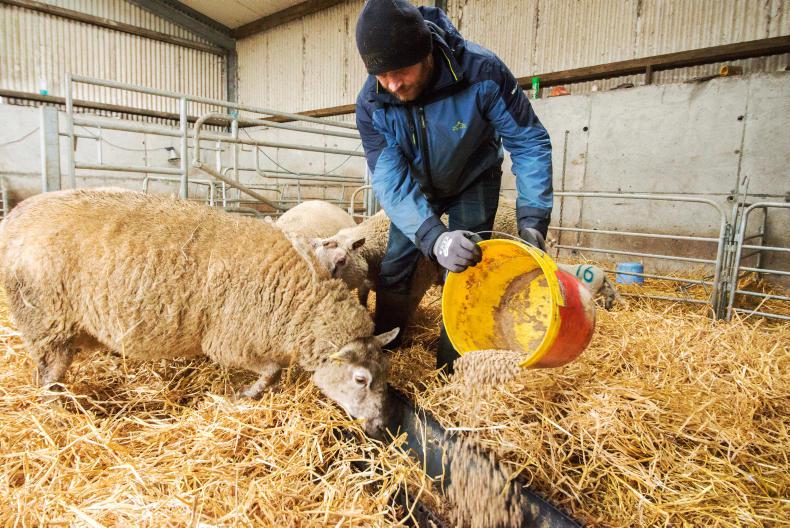At this stage of pregnancy, ewes are vulnerable to many nutritional diseases.
Recently we have seen an increase in cases of pregnancy toxaemia (twin lamb disease) and hypocalcaemia.
These nutritional diseases can be brought on following a stressful event such as current adverse weather conditions, housing or handling.
Pregnancy toxaemia is caused by increased energy demands of late pregnancy exceeding the energy intake from the diet.
Affected ewes appear disorientated and become isolated from the rest of the flock, with a depressed appetite.
If this is not treated in the early stage, ewes become increasingly dull, blind and eventually become recumbent.
Treatment must be commenced at the first signs of disease, as where the disease is allowed to progress, ewes rarely survive.
Treatment consists of propylene glycol, intravenous or sub-cutaneous glucose injection and steroid injection.
Ewes suffering from pregnancy toxaemia should be checked regularly for signs of lambing or abortion as they often won’t be able to expel foetuses normally due to muscle weaknesses.
Due to the poor response to treatment, prevention is much the preferred option. This is achieved by feeding highly palatable high-energy dense feed according to scanning results and body condition score during the last six weeks of pregnancy.
Stress should be minimised and feeding of concentrates should be commenced before any anticipated stressful events.
Hypocalcaemia is another common disease in late pregnancy and occasionally in early lactation. Ewes become depressed, weak and are unable to stand. Affected ewes may appear bloated with a wet lower jaw and muzzle.
Unlike pregnancy toxaemia, response to treatment is usually rapid. Treatment with intravenous calcium often sees affected ewes return to standing within five to 10 minutes.
Treatment with sub-cutaneous calcium can achieve positive results also if the disease is detected in the early stages. Calcium solution should be heated to body temperature before sub-cutaneous administration and given in multiple sites to speed absorption and treated ewes should return to standing within four hours.
Again, as with pregnancy toxaemia, prevention is the best cure and avoiding stress is the key factor. Appropriate feeding of concentrates with correct mineral levels will help minimise the risk of disease.
Paul Barnes works at Kilcoyne & Barnes Veterinary, Mountain Rd, Tubbercurry, Co Sligo. Kilcoyne Veterinary is part of XLVets. XLVets is a group of progressive practices who are working together to achieve a better future for agriculture and veterinary in Ireland. Visit www.xlvets.ie.
Read more
Dealing with adverse weather and keeping ewes and lambs indoors
At this stage of pregnancy, ewes are vulnerable to many nutritional diseases.
Recently we have seen an increase in cases of pregnancy toxaemia (twin lamb disease) and hypocalcaemia.
These nutritional diseases can be brought on following a stressful event such as current adverse weather conditions, housing or handling.
Pregnancy toxaemia is caused by increased energy demands of late pregnancy exceeding the energy intake from the diet.
Affected ewes appear disorientated and become isolated from the rest of the flock, with a depressed appetite.
If this is not treated in the early stage, ewes become increasingly dull, blind and eventually become recumbent.
Treatment must be commenced at the first signs of disease, as where the disease is allowed to progress, ewes rarely survive.
Treatment consists of propylene glycol, intravenous or sub-cutaneous glucose injection and steroid injection.
Ewes suffering from pregnancy toxaemia should be checked regularly for signs of lambing or abortion as they often won’t be able to expel foetuses normally due to muscle weaknesses.
Due to the poor response to treatment, prevention is much the preferred option. This is achieved by feeding highly palatable high-energy dense feed according to scanning results and body condition score during the last six weeks of pregnancy.
Stress should be minimised and feeding of concentrates should be commenced before any anticipated stressful events.
Hypocalcaemia is another common disease in late pregnancy and occasionally in early lactation. Ewes become depressed, weak and are unable to stand. Affected ewes may appear bloated with a wet lower jaw and muzzle.
Unlike pregnancy toxaemia, response to treatment is usually rapid. Treatment with intravenous calcium often sees affected ewes return to standing within five to 10 minutes.
Treatment with sub-cutaneous calcium can achieve positive results also if the disease is detected in the early stages. Calcium solution should be heated to body temperature before sub-cutaneous administration and given in multiple sites to speed absorption and treated ewes should return to standing within four hours.
Again, as with pregnancy toxaemia, prevention is the best cure and avoiding stress is the key factor. Appropriate feeding of concentrates with correct mineral levels will help minimise the risk of disease.
Paul Barnes works at Kilcoyne & Barnes Veterinary, Mountain Rd, Tubbercurry, Co Sligo. Kilcoyne Veterinary is part of XLVets. XLVets is a group of progressive practices who are working together to achieve a better future for agriculture and veterinary in Ireland. Visit www.xlvets.ie.
Read more
Dealing with adverse weather and keeping ewes and lambs indoors






 This is a subscriber-only article
This is a subscriber-only article










SHARING OPTIONS: